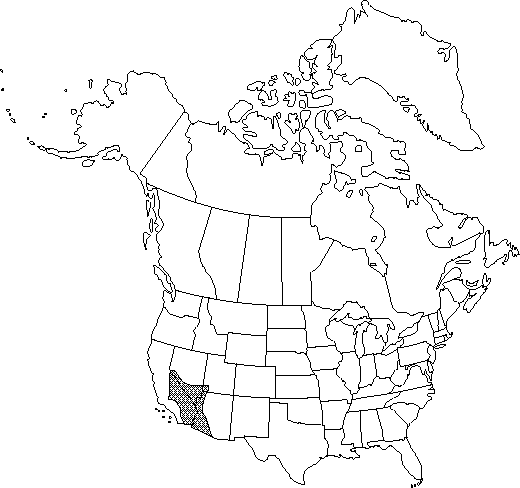Difference between revisions of "Eschscholzia minutiflora"
Proc. Amer. Acad. Arts 11: 122. 1876.
FNA>Volume Importer |
imported>Volume Importer |
||
| (7 intermediate revisions by 2 users not shown) | |||
| Line 9: | Line 9: | ||
|special_status={{Treatment/ID/Special_status | |special_status={{Treatment/ID/Special_status | ||
|code=F | |code=F | ||
| − | |label= | + | |label=Illustrated |
}} | }} | ||
|basionyms= | |basionyms= | ||
| Line 15: | Line 15: | ||
|name=Eschscholzia covillei | |name=Eschscholzia covillei | ||
|authority=Greene | |authority=Greene | ||
| − | }}{{Treatment/ID/Synonym | + | |rank=species |
| + | }} {{Treatment/ID/Synonym | ||
|name=Eschscholzia minutiflora subsp. covillei | |name=Eschscholzia minutiflora subsp. covillei | ||
|authority=(Greene) C. Clark | |authority=(Greene) C. Clark | ||
| − | }}{{Treatment/ID/Synonym | + | |rank=subspecies |
| + | }} {{Treatment/ID/Synonym | ||
|name=Eschscholzia minutiflora subsp. twisselmanii | |name=Eschscholzia minutiflora subsp. twisselmanii | ||
|authority=C. Clark & M. Faull | |authority=C. Clark & M. Faull | ||
| − | }}{{Treatment/ID/Synonym | + | |rank=subspecies |
| + | }} {{Treatment/ID/Synonym | ||
|name=Eschscholzia minutiflora var. darwinensis | |name=Eschscholzia minutiflora var. darwinensis | ||
|authority=M. E. Jones | |authority=M. E. Jones | ||
| + | |rank=variety | ||
}} | }} | ||
|hierarchy=Papaveraceae;Eschscholzia;Eschscholzia minutiflora | |hierarchy=Papaveraceae;Eschscholzia;Eschscholzia minutiflora | ||
| Line 32: | Line 36: | ||
}}<!-- | }}<!-- | ||
| − | --><span class="statement" id="st- | + | --><span class="statement" id="st-undefined" data-properties=""><b>Plants </b>annual, caulescent, erect or spreading, 5-35 cm. <b>Leaves</b> basal and cauline; blade grayish or bluish green, glabrous, glaucous; ultimate lobes usually obtuse, terminal broadened at apex. <b>Inflorescences</b> cymose or 1-flowered; buds nodding. <b>Flowers</b>: receptacle obconic, cup without spreading free rim; calyx acuminate, glabrous, sometimes glaucous; petals yellow, sometimes with orange spot at base, 3-26 mm. <b>Capsules</b> 3-6 cm. <b>Seeds</b> brown to black, ellipsoid, 1-1.4 mm, reticulate. <b>2n</b> = 12, 24, 36.</span><!-- |
-->{{Treatment/Body | -->{{Treatment/Body | ||
| Line 38: | Line 42: | ||
|habitat=Desert washes, flats, and slopes | |habitat=Desert washes, flats, and slopes | ||
|elevation=0-2000 m | |elevation=0-2000 m | ||
| − | |distribution=Ariz.;Calif.;Nev.;Utah;nw Mexico | + | |distribution=Ariz.;Calif.;Nev.;Utah;nw Mexico. |
| − | |discussion=<p>Eschscholzia minutiflora is highly variable in flower size. Typically, plants are hexaploid (2n = 36) with petals 3-10 mm. Tetraploid plants (2n = 24) with petals 6-18 mm, from the northern and central Mojave Desert of California, have been distinguished as subsp. covillei. Diploid plants (2n = 12) with petals 10-26 mm, restricted to the El Paso and Rand mountains of the western Mojave Desert, have been distinguished as E. minutiflora subsp. twisselmannii and are considered to be of conservation concern; previously they were misattributed to E. parishii.</p> | + | |discussion=<p><i>Eschscholzia minutiflora</i> is highly variable in flower size. Typically, plants are hexaploid (2n = 36) with petals 3-10 mm. Tetraploid plants (2n = 24) with petals 6-18 mm, from the northern and central Mojave Desert of California, have been distinguished as subsp. covillei. Diploid plants (2n = 12) with petals 10-26 mm, restricted to the El Paso and Rand mountains of the western Mojave Desert, have been distinguished as <i>E. minutiflora</i> subsp. twisselmannii and are considered to be of conservation concern; previously they were misattributed to <i>E. parishii</i>.</p> |
|tables= | |tables= | ||
|references={{Treatment/Reference | |references={{Treatment/Reference | ||
| Line 54: | Line 58: | ||
-->{{#Taxon: | -->{{#Taxon: | ||
name=Eschscholzia minutiflora | name=Eschscholzia minutiflora | ||
| − | |||
|authority=S. Watson | |authority=S. Watson | ||
|rank=species | |rank=species | ||
| Line 64: | Line 67: | ||
|habitat=Desert washes, flats, and slopes | |habitat=Desert washes, flats, and slopes | ||
|elevation=0-2000 m | |elevation=0-2000 m | ||
| − | |distribution=Ariz.;Calif.;Nev.;Utah;nw Mexico | + | |distribution=Ariz.;Calif.;Nev.;Utah;nw Mexico. |
|reference=clark1991a;mosquin1961a | |reference=clark1991a;mosquin1961a | ||
|publication title=Proc. Amer. Acad. Arts | |publication title=Proc. Amer. Acad. Arts | ||
|publication year=1876 | |publication year=1876 | ||
| − | |special status= | + | |special status=Illustrated |
| − | |source xml=https:// | + | |source xml=https://bitbucket.org/aafc-mbb/fna-data-curation/src/2e0870ddd59836b60bcf96646a41e87ea5a5943a/coarse_grained_fna_xml/V3/V3_124.xml |
|genus=Eschscholzia | |genus=Eschscholzia | ||
|species=Eschscholzia minutiflora | |species=Eschscholzia minutiflora | ||
| − | |||
| − | |||
| − | |||
| − | |||
| − | |||
| − | |||
| − | |||
| − | |||
| − | |||
| − | |||
| − | |||
| − | |||
| − | |||
| − | |||
| − | |||
| − | |||
| − | |||
| − | |||
| − | |||
| − | |||
| − | |||
| − | |||
| − | |||
| − | |||
| − | |||
}}<!-- | }}<!-- | ||
-->[[Category:Treatment]][[Category:Eschscholzia]] | -->[[Category:Treatment]][[Category:Eschscholzia]] | ||
Latest revision as of 22:46, 5 November 2020
Plants annual, caulescent, erect or spreading, 5-35 cm. Leaves basal and cauline; blade grayish or bluish green, glabrous, glaucous; ultimate lobes usually obtuse, terminal broadened at apex. Inflorescences cymose or 1-flowered; buds nodding. Flowers: receptacle obconic, cup without spreading free rim; calyx acuminate, glabrous, sometimes glaucous; petals yellow, sometimes with orange spot at base, 3-26 mm. Capsules 3-6 cm. Seeds brown to black, ellipsoid, 1-1.4 mm, reticulate. 2n = 12, 24, 36.
Phenology: Flowering late winter–spring (Mar–May).
Habitat: Desert washes, flats, and slopes
Elevation: 0-2000 m
Distribution

Ariz., Calif., Nev., Utah, nw Mexico.
Discussion
Eschscholzia minutiflora is highly variable in flower size. Typically, plants are hexaploid (2n = 36) with petals 3-10 mm. Tetraploid plants (2n = 24) with petals 6-18 mm, from the northern and central Mojave Desert of California, have been distinguished as subsp. covillei. Diploid plants (2n = 12) with petals 10-26 mm, restricted to the El Paso and Rand mountains of the western Mojave Desert, have been distinguished as E. minutiflora subsp. twisselmannii and are considered to be of conservation concern; previously they were misattributed to E. parishii.
